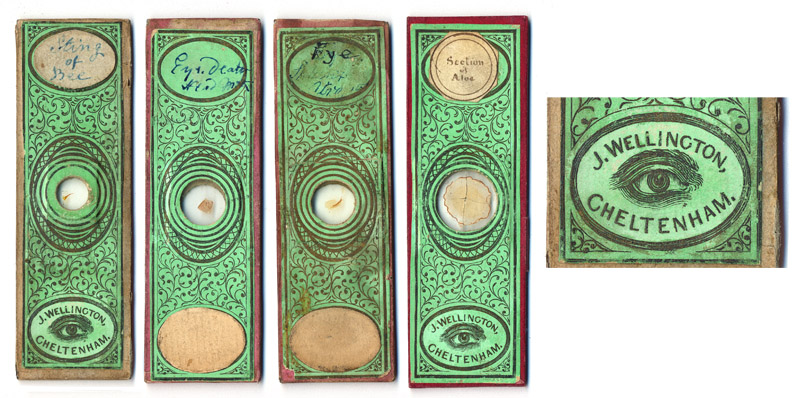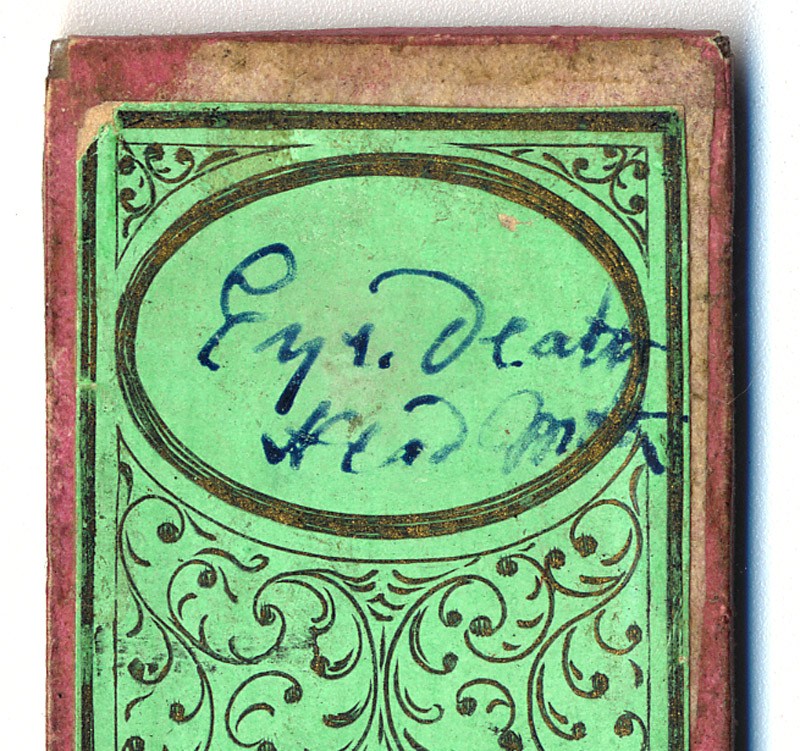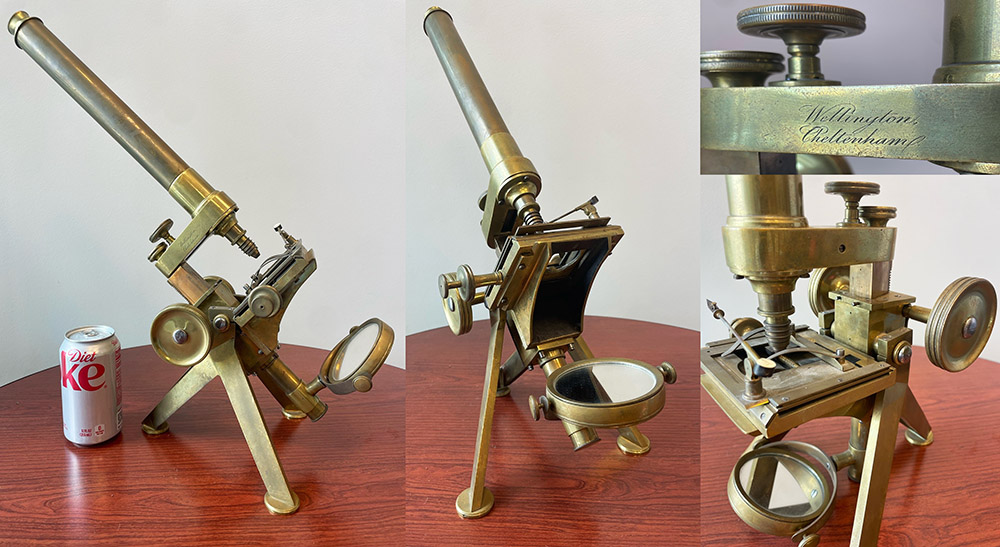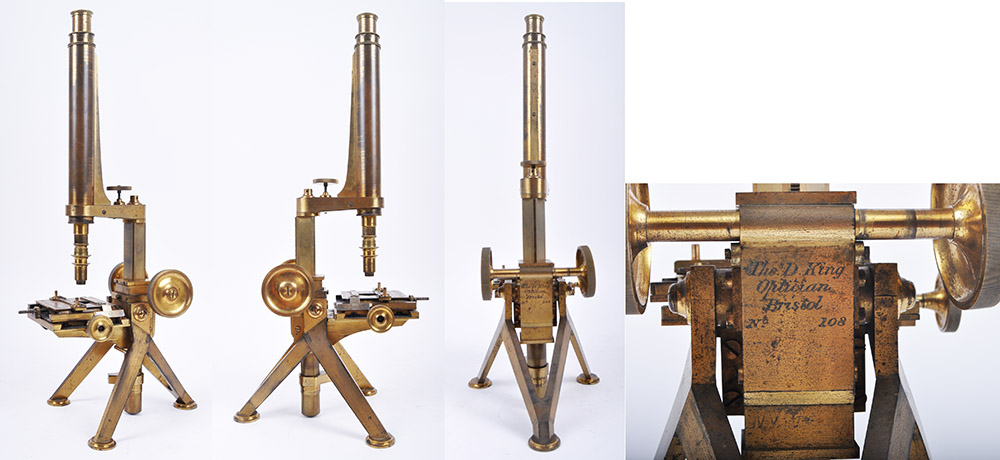Joseph Wellington, ca. 1800 – 1884
by Brian Stevenson
last updated September, 2023
Joseph Wellington’s microscope slides bear one of the most attractive and unique patterned papers of the Victorian era (Figure 1). A flowing vine pattern covers most of the paper, distinctive from any other slide paper pattern with which I am familiar. An oval carries Wellington’s name and
address, surrounding a large eye. That symbol has long been associated with optical businesses, and reflects Wellington’s profession as a “philosophical instrument &c. maker” during the early 1850s. Evidence indicates that Wellington re-sold slides which were produced by outside makers. For example, the Wellington slide shown in Figure 2 clearly shows that an earlier top paper was partly removed prior to application of the Wellington paper.
To date, a single microscope is known that is signed "Wellington, Cheltenham" (Figure 3). It is very similar to a model that was produced by Thomas D. King (1819-1884), who operated a microscope-manufacturing business in Bristol between ca. 1850 and ca. 1858. Cheltenham is approximately 40 miles / 65 km north of Bristol. Noting that King was definitely a manufacturer and evidently sold other examples on the wholesale market, while there are no indications of Wellington having training in microscope building, we consider it very likely that Wellington acquired this instrument from King, had his name inscribed, then resold it.
Based on census and directory information, Wellington-labeled slides and microscope(s) date from the 1850s.

Figure 1.
Examples of ca. 1850s microscope slides labeled by Joseph Wellington, Cheltenham. An enlargement of Wellington’s distinctive eye is shown to the right. The blank, white oval labels on the middle two slides were probably applied by a later re-seller, to hide Wellington’s name.

Figure 2.
Magnified view of a Wellington-labeled slide, showing traces of a previous top paper that was removed prior to application of the Wellington paper.

Figure 3.
A ca. 1850s microscope that is signed "Wellington, Cheltenham". It is very similar to a model that was manufactured by Thomas King, of Bristol (Figure 4). Images courtesy of David Brigstock.

Figure 4.
A bar-limb microscope, on a tripod base, by Thomas D. King, of Bristol. Serial number 108. Adapted for nonprofit, educational purposes from an internet auction site.
History does not appear to have recorded much of Joseph Wellington or his works. I did not locate any records of him joining any microscopy or other scientific societies, nor have I found any advertisements from him. Although Wellington was recorded on the 1851 census as a “philosophical instrument &c. maker”, and the eye design implies an optical business, I have not found any
information on his instruments. The Webster Signature Database does not have any records of Joseph Wellington.
According to census records, Joseph Wellington was born approximately 1800, in Shobdon, Herefordshire, England. His wife, Elizabeth, was originally from Carmarthen, Wales. They had two, possibly three, daughters. Kezia was born 1837, and Lydia was born 1839. The 1841 census, which did not record personal relationships, noted that the household included Hephzibah Wellington, born ca. 1825. She was not mentioned on later censuses. Kezia and Lydia remained with their parents
through 1861. In 1841, the Wellingtons lived in Cheltenham. In 1851 and 1861, they were at Springfield Cottage, in nearby Leckhampton. Records from 1863 and 1868 have them at Laurien Villa, Cheltenham, and from 1871 onward at Denmark Cottage, Cheltenham. Joseph died during the summer of 1884, at the age of 84.
Pigot’s Directory for Gloucestershire, 1830, reported that Joseph Wellington lived in Cheltenham. He was then employed at the Charity School (renamed Cheltenham Parish Church
School in 1866). With the exception of 1851, all censuses recorded Wellington as working as a teacher or lecturer: “British teacher” in 1841, “lecturer on the sciences” in 1861 and 1871, and “lecturer on telegraphy” in 1881. Whether he was continually employed at the
Cheltenham Charity/Parish School, or also worked at other area schools, is not known. He may have been a public lecturer, although I have not uncovered any published announcements for such talks. The 1863 Post Office Directory of Gloucestershire highlighted Joseph Wellington’s entry with “esq.”, and the 1868 Slater’s Directory of Gloucestershire listed Mr. Joseph Wellington under “gentry, &c.”. Those entries are consistent with Wellington being a teacher/lecturer, but not with a tradesman.
As noted above, the 1851 census referred to Wellington as a maker of scientific instruments. The 1856 Post Office Directory of Gloucestershire, Bath and Bristol did not list Wellington as an optician or owner of any other business, nor did any later directory. This suggests that the business had closed by then. Thus, Wellington-labeled slides and microscope(s) most likely date from ca. 1850s.
Acknowledgements
Thank you to David Brigstock for sharing images of his Wellington-signed microscope, and to Joe Zeligs for helpful insights.
Resources
England census, birth and death records, accessed through ancestry.co.uk
National Archives (accessed
August, 2012) Cheltenham Parish Church Schools, http://www.nationalarchives.gov.uk/A2A/records.aspx?cat=040-sm785&cid=-1&Gsm=2012-06-18#-1
Pigot's Directory for Gloucestershire (1830) Cheltenham, accessed through
http://www.genuki.org.uk/big/eng/GLS/Cheltenham/Pigot1830.txt
Post Office Directory of Gloucestershire, Bath and Bristol (1856)
Post Office Directory of Gloucestershire, Herefordshire, Shropshire and the City of Bristol (1863) Entries for Joseph Wellington, esq., pages
225 and 405
Slater's Directory of Gloucestershire, Herefordshire, Monmouthshire, Shropshire and Wales (1868) Entry for Mr. Joseph Wellington, page 157
Webster Signature Database (accessed August, 2012) http://historydb.adlerplanetarium.org/signatures/



